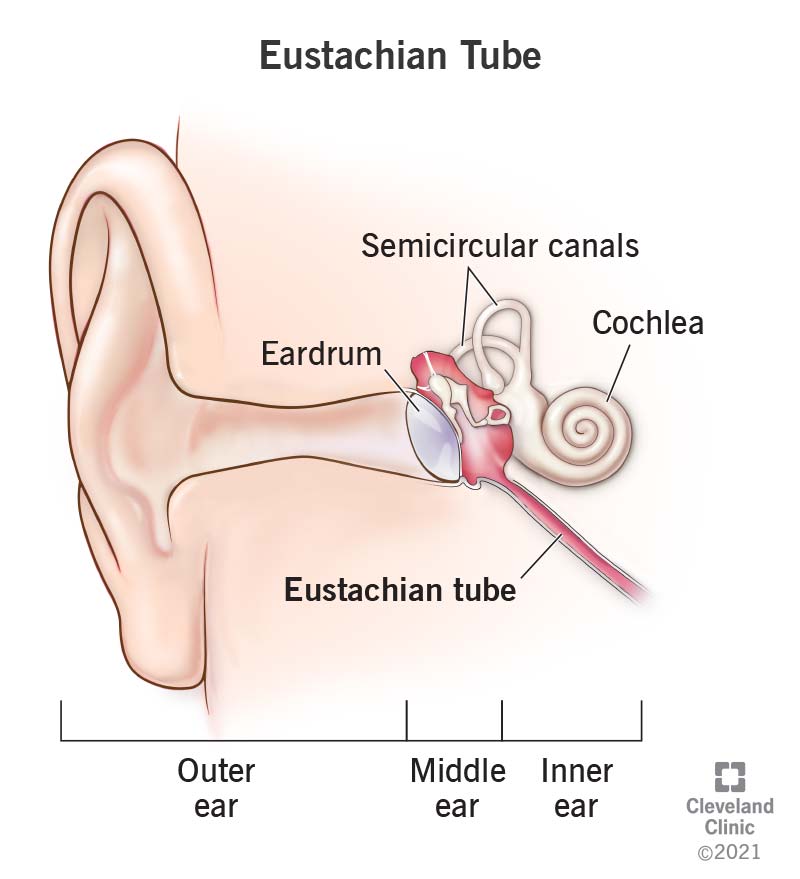Eustachian tubes connect your middle ears to the back of your throat. The tubes help drain fluid from your middle ear and balance air pressure inside your ears. Allergies, colds or infections can cause eustachian tube dysfunction. This is a broad term for issues that keep your eustachian tubes from working like they should.
Advertisement
Cleveland Clinic is a non-profit academic medical center. Advertising on our site helps support our mission. We do not endorse non-Cleveland Clinic products or services. Policy

Your eustachian (you-STAY-shee-un) tubes are tubes made of bone and cartilage that run from your middle ears to the back of your nose and throat. Healthcare providers may call them auditory (hearing) tubes or pharyngotympanic (throat to eardrum) tubes. Eustachian tubes are named for Bartolomeo Eustachi, the doctor who discovered how the tubes connect middle ears to noses and throats.
Advertisement
Cleveland Clinic is a non-profit academic medical center. Advertising on our site helps support our mission. We do not endorse non-Cleveland Clinic products or services. Policy
Eustachian tubes protect your middle ear from issues that can affect your hearing. Allergies, colds or infections can cause eustachian tube dysfunction (ETD), a broad term for when your eustachian tubes don’t open or close normally.
Your eustachian tubes have three primary functions. They:
You have two eustachian tubes, one on each side of your face, measuring 12 millimeters (mm, half an inch) long and 2 to 3 mm (one-eighth inch) wide.
Your eustachian tube has two sections. One is near your middle ear, measures 12 mm long and is made of bone. The second section is closer to your nose and throat, measures 24 mm (just under an inch) and is made of cartilage.
The most common issue is eustachian tube dysfunction, which may develop if your eustachian tubes swell. This can happen if you have:
Advertisement
These conditions may cause the following symptoms:
These symptoms may go away on their own. But you should contact a healthcare provider if you have symptoms that last for more than two weeks.
A healthcare provider will examine your eardrum for disease or damage. They may ask you to do a Valsalva maneuver, or to follow these steps to open your clogged eustachian tubes:
They may do tests to see if your eustachian tubes open and close normally. Your eustachian tubes should only open when you do things like yawn, chew or swallow.
Eustachian tube massage is one home remedy. To do this, you:
Other home remedies are:
Chewing gum.
If home remedies don’t work, your provider may refer you to an otolaryngologist (ear, nose and throat specialist or ENT) for more tests and treatment. Procedures to treat your eustachian tubes include:
Your ears aren’t always the reason why you have symptoms like ringing or fullness in your ears. Sometimes, your eustachian tubes are to blame. Your eustachian tubes help keep your middle ear healthy. Allergies, colds or infections can affect your eustachian tube and how they function.
Most of the time, eustachian tube issues go away on their own or by using home remedies like chewing gum or yawning. But you should schedule a visit with a healthcare provider if your symptoms last more than two weeks.
Advertisement
Fluid behind your eardrum can cause constant earaches and fullness. Ear tube surgery, or tympanostomy, at Cleveland Clinic can help you feel — and hear — better.

Last reviewed on 04/02/2024.
Learn more about the Health Library and our editorial process.